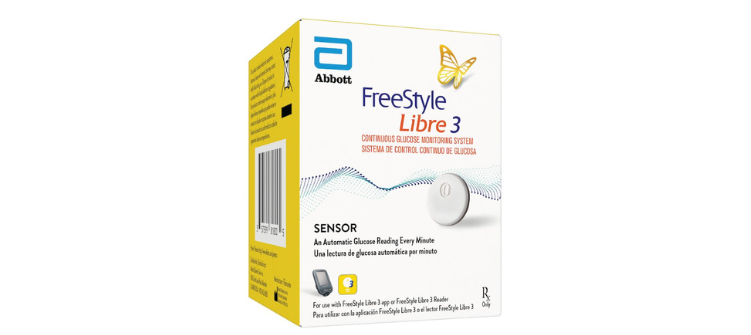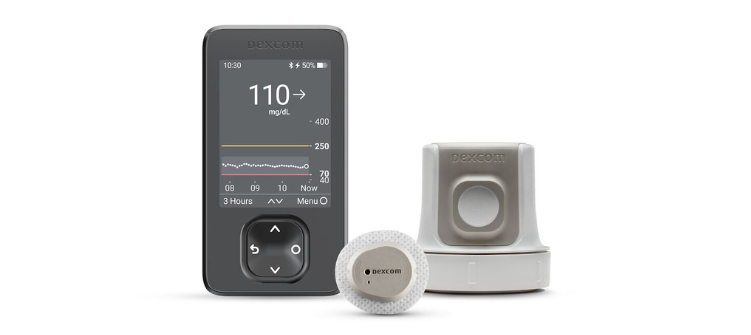
When it comes to diabetes management, continuous glucose monitoring systems have revolutionized how individuals monitor and manage their blood sugar levels. In fact, for those living with diabetes, selecting the right CGM system can profoundly impact their daily routines and overall well-being. It can make management easier and give you more control without overwhelming your decision fatigue. To help you find the best option for your lifestyle, we've put together a list of some of the best continuous glucose monitors for 2024.
What is a Continuous Glucose Monitor?
A continuous glucose monitor (CGM) is a device used in diabetes care to estimate blood glucose levels automatically throughout the day. They allow individuals with type 1 and type 2 diabetes to see their blood sugar levels at any time without the need for a fingerstick.
CGM data is collected by a sensor inserted under the skin and transmitter; secured on the abdomen, arm, or upper buttock with an adhesive patch. Most CGM sensors are disposable and need to be changed every 7 to 14 days, depending on the model. Using a transmitter, the sensors share data with your smart phone, Insulin pump or provided CGM receiver This allows you to see your glucose readings in real-time (1,3, or 5 minute increments) throughout the day (as with intermittent scanners).
However, all types of CGMs are different, so it's important to understand which model will help you manage your diabetes and how it works. This is especially important regarding the differences between real-time CGM devices and intermittent-scan CGM devices. Real-time devices will provide blood glucose readings automatically to your receiver or smartphone. Intermittent-scan devices require you to scan your CGM sensor with your smartphone every few hours to view the data. Both still provide data about your blood glucose values, but one requires more effort to get a reading.
How Can CGM Devices Help People with Diabetes?
Continuous glucose monitors can improve the lives of people with diabetes in several ways. While they won't directly impact blood sugar, they can be paired with insulin pumps for automated insulin delivery to help optimize blood sugar management. This can make individual management more streamlined and simplified, reducing the mental and psychological strain of managing this chronic condition.
Seeing your glucose data without having to prick yourself with a needle multiple times a day can also make diabetes management more effective (and less painful). It can help you make more informed decisions regarding your medications and insulin administration, thus reducing your risk of diabetes complications.
For example, seeing what blood sugars are doing between meals and overnight can help you work with your healthcare providers to tailor in medication and dosage decisions. You can also more clearly see the impacts of lifestyle adjustments like food choices and physical activity on your blood sugars and make more impactful choices.
One of the most important benefits of CGM use is that they can alert us to high or low blood sugars as they are happening, or even when they are predicted to happen in the near future. This allows people with diabetes to respond more quickly to high blood sugars and reduce time spent high of target range. Most importantly it gives an important safety backup with a warning of low blood sugars allowing for safe treatment before risk of harm or dangerous situations. This allows us to be more confident with diabetes management.
Best Continuous Glucose Monitors in 2024
Living with type 1 diabetes, type 2 diabetes, or a less common type of diabetes can put a lot of stress on your life physically, mentally, and emotionally. To help monitor your blood sugar in a simpler, more comfortable way, consider some of the best continuous glucose monitors on the market.

Abbott FreeStyle Libre 3 CGM Sensor — The Freestyle Libre 3 system introduces the world's smallest sensor, with smartphone compatibility and real-time glucose alarms. Learn more here.

Dexcom G7 CGM System (Integrates with Tandem t:X2 and Mobi Insulin Pump) — The Dexcom G7 represents the latest innovation from Dexcom, promising further miniaturization and improved performance compared to its predecessor. Thanks to its advancement in sensor technology, it delivers real-time glucose numbers 24/7 to your smartphone or smartwatch without needing fingersticks, scanning, or calibrations. The Dexcom G7 also encompasses many of the G6 features. You can find more information on Dexcom's website here.

Medtronic GuardianTM Connect System (Integrates with Medtronic Mini Med Pump Systems) — The GuardianTM Connect System uses smart technology to predict where glucose levels are headed before they get there. You can find more information on Medtronic's website here.

Eversense® CGM System — The Eversense® CGM System is a long-term CGM system with a fully implantable sensor that lasts from three to six months. With a rechargeable transmitter that is worn on the skin. With vibrating on body alerts this can be an ideal CGM system for active persons who may lose connectivity to a receiver or other device. You can find more information on their website here.
Things to Consider When Choosing a System That's Right for You
To help you choose which CGM to get, it's important to work with your healthcare provider and understand the features of each make and model. Some factors to consider include:
- Ease of Use — Since you'll need to change your CGM regularly or so, finding one that's easy to place and use is important. Many systems require the same application process, so it may simply come down to personal preference.
- Smartphone Compatibility — To calibrate your readings and access them easily, your smartphone should be compatible. Some technology may not work on certain operating systems, so it's important to check prior to purchasing one.
- Real-Time Data or Scan Frequency — Some CGM provide real-time data with scans every 15 minutes (or less), while others require you to scan them manually using your receiver to get the data.
- Additional Event Tracking — Some CGMs allow for additional food and exercise tracking in third-party apps. Others may allow for sleep logs and stress input. This can help you better understand your blood sugar trends and make more informed decisions about lifestyle habits.
- Water Resistance — Some CGMs are waterproof, while some are water resistant. If you have an active lifestyle and spend a lot of time in the water, it's important to check these specifications.
- Support — Many manufacturers offer user support through videos, app explanations, and phone lines for their technology.
- Cost and Insurance Coverage — Some CGMs are covered by insurance and Medicare, while others might not be. You'll need to check with your provider if you want to use a CGM before placing an order.
Continuous glucose monitors can help you catch high or low blood sugar readings early so you can administer medication or insulin and avoid associated complications. Some continuous blood glucose meters can even be used on individuals as young as two years old, providing parents with reassuring CGM readings throughout the day.
If you or a loved one are living with diabetes and interested in trying a CGM system, talk to your doctor today. CGMs can be covered by your insurance, so it's worth looking at your options. Talk to your doctor about obtaining a prescription, and contact your insurance provider to learn more. For additional diabetes support and management, Byram Healthcare has a range of continuous blood glucose monitors. We also offer diabetes supplies and educational materials to give you everything you need for comprehensive care.




